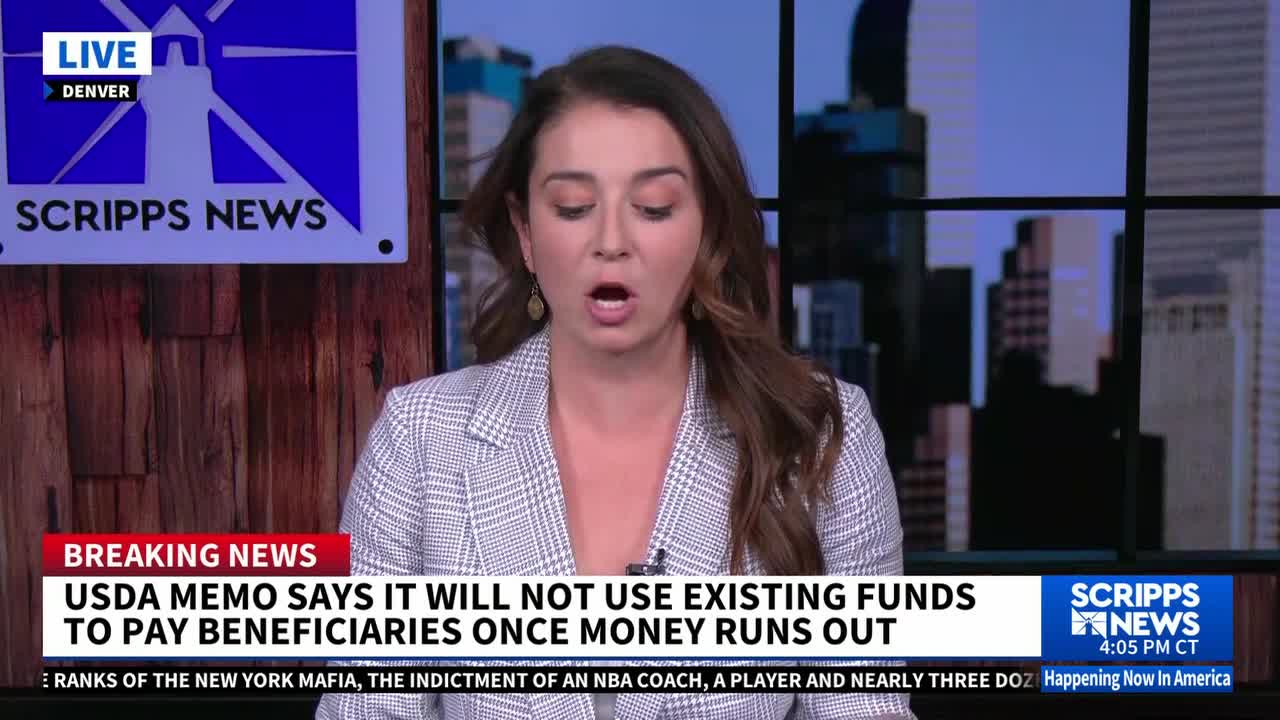The U.S. Department of Agriculture will not use any of the more than $5 billion in emergency funding it maintains to provide food assistance to needy families during the government shutdown, nor will it reimburse states that try to provide such benefits themselves, according to an agency memo obtained by Scripps News on Friday.
Trump administration officials argue they’re unable to use the funds for the Supplemental Nutrition Assistance Program (SNAP) during a lapse in appropriations, and instead are holding onto them for true emergencies like “hurricanes, tornadoes, and floods, that can come on quickly and without notice.”
“SNAP contingency funds are only available to supplement regular monthly benefits when amounts have been appropriated for, but are insufficient to cover, benefits,” the unsigned memo states. “The contingency fund is not available to support FY 2026 regular benefits, because the appropriation for regular benefits no longer exists.”
Moreover, “there is no provision or allowance under current law for States to cover the cost of benefits and be reimbursed,” the memo stated, so states and local jurisdictions that try to use their own funds to provide SNAP assistance shouldn’t expect any reimbursement from the federal government.
News of the memo’s existence was first reported by Axios.
The agency’s announcement means the nearly 42 million low-income Americans who rely on that assistance, often referred to as food stamps, are likely to go without them starting next month, absent a long-shot deal to reopen the government. Earlier in October, the Acting Associate Administrator of SNAP Ronald Ward penned a letter to states warning that “there will be insufficient funds to pay full November SNAP benefits” should the shutdown drag on.
Democrats in Congress and at the state level, meanwhile, have argued the Trump administration has a legal obligation to use the emergency funds to help pay out SNAP benefits. In a letter to Secretary of Agriculture Brooke Rollins earlier Friday, 214 House Democrats said they were “deeply concerned” that the agency might not use the contingency funds, “which Congress provides precisely for this reason.”
Indeed, the Center for Budget and Policy Priorities (CBBP), a left-leaning think tank, argued as much in a recent analysis.
While the emergency funds likely wouldn’t cover the entirety of SNAP beneficiaries’ November benefits, estimated to cost more than $8 billion in total, the agency should “at a minimum” use the contingency funding “to provide partial benefits to eligible households for November,” the CBBP authors wrote.
Their analysis pointed to a since-deleted USDA contingency plan for a government shutdown in which officials indicated the emergency funds could be used for SNAP benefits.
“Congressional intent is evident that SNAP’s operations should continue since the program has been provided with multi-year contingency funds,” the document stated.
RELATED STORY | Federal workers miss first full paychecks as shutdown becomes second-longest in US history
Asked about the USDA’s new memo arguing the contrary, CBBP officials pointed Scripps News to a post by the think tank arguing the USDA was “choosing not to use them in an effort to gain political advantage, leaving millions of families across the country to suffer as a result.”
Shortly after the news of the USDA memo was public, all 45 Senate Democrats sent a letter to Rollins demanding she use the emergency funds to help pay for SNAP benefits and “utilize all available legal authorities so that American families can get benefits without interruption.”
Since the shutdown began, the Trump administration has in other cases moved money around within government accounts in order to fulfill obligations during the shutdown – including within the USDA. Earlier in October, Rollins utilized legal authorities to transfer $300 million from the Child Nutrition budget account to the Women, Infants and Children (WIC) program, which provides food and nutrition assistance to low-income pregnant and postpartum women as well as children up to age five.
The USDA memo, conversely, argued doing so for SNAP would amount to “pull[ing] away funding for school meals and infant formula.”
“This Administration will not allow Democrats to jeopardize funding for school meals and infant formula in order to prolong their shutdown,” the memo stated.
Asked about the Democrats' letters, and why the agency was no longer following the guidance of their previous shutdown contingency plan, a spokesperson told Scripps News in an email that the impending SNAP funds expatriation represented "an inflection point for Senate Democrats."
"Continue to hold out for the Far-Left wing of the party or reopen the government so mothers, babies, and the most vulnerable among us can receive timely WIC and SNAP allotments," the spokesperson added.





